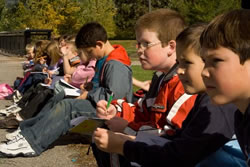For the 2007-2008 school year, ECOS fellows implemented a year-long Seasonal Schoolyard Science program to help teachers and their students investigate seasonal change, or phenology, in the areas around their schools. In particular, the program was designed to help guide students through the steps of the scientific method (Making Observations and Asking Questions, Collecting Data, Making Predictions, and Designing a Fair Test). Our Fall, Winter, Early Spring, and Late Spring school visits were focused on exploring the unique ecology of that specific season, and on practicing a particular step of the scientific method. Each visit fit into a 1-hour class period and was designed to build on the ecological knowledge and scientific skills gained in previous visits. The program culminated in a fun, fast-paced ECOS Olympics that reviewed and challenged students’ skills with each of the steps of the scientific method, and gave them an opportunity to ask “What do I want to know next about the ecology of my schoolyard?” and “How would I go about answering this question?” Like the previous visits, the ECOS Olympics was designed to fit into a 1-hour class period, allowing 10-15 minutes for each of four “Olympic events.”
Who’s in our schoolyard?
Fall (October-November)
Our schoolyards are teeming with fascinating living things (besides the students)… we just have to look! To explore “Who’s there?” students make observations and ask questions, the most important skills of any ecologist! Who's in our schoolyard? details...
Where did they go?
Winter (November-January)
Organisms have different strategies for surviving the winter months, but most of them just “hunker down.” How do they do it? Building on their fall observations, students collect data on how the organisms in their schoolyard are chilling out for the winter! Where did they go? details...
When will they come back?
Early Spring (February-March)
Who will come back to the schoolyard first? When? Where? Students continue to collect data to investigate schoolyard microclimates. Then, they make predictions about when and where organisms will start popping up around their schoolyard. When will they come back? details...
How do we know? and What do we want to know next?
Late Spring (April-May)
By now, the bugs are buzzing and the blossoms are blooming…time for the ECOS Olympics! Students participate in a fun and fast-paced series of four “Olympic events,” inquiries designed to review and challenge students’ skills with the scientific method. In particular, students are given the opportunity to design fair tests for their predictions about when and where organisms will re-emerge around their schoolyards, and to brainstorm ideas on what they would like to investigate next, and how. How do we know? and What do we want to know next?
Seasonal Schoolyard Science and the ECOS Olympics align with the following Missoula County Public Schools science standards:
- Science as Inquiry (Standard 1)
- Unifying Concepts of Science (Standard 2)
- Humans and Science (Standard 3)
- Physical Science (Standard 4)
- Life Science (Standard 5)
- Earth and Space Science (Standard 6)



 Funded by the National Science Foundation
Funded by the National Science Foundation